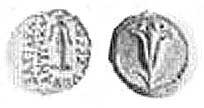Ancient Jewish Coins: The Syrian-Judean Coin Connection
(142 - 131 BCE)
According to the First Book of Maccabees, Antiochus VII Sidetes, King of Syria, granted the last of the Maccabee brothers, Simon (142-135 BCE) “leave also to coin money for thy country with thine own stamp” (I Maccabees 15:2-9). Unfortunately, no Jewish coins of this period are known; perhaps because this right was withdrawn along with other political privileges extended to Simon after his murder and the accession to the throne of his son John Hyrcanus I. Antiochus thereupon besieged Jerusalem and extracted a tribute of 500 talents of gold, equivalent to 1 ½ million shekels!
Coinage was considered an important symbol of sovereignty and so when Antiochus VII gained sufficient control in Jerusalem, he struck small bronze coins there that appear to be half Jewish, half Syrian. One side features a Syrian anchor (upside down) with the Greek inscription “Of King Antiochus, Benefactor,” and below is the date APR (Year 181 of the Seleucid era = 132/1 BCE) or the following year BPR. The reverse is typically Judaean - a lily - a symbol associated with Jerusalem.
 |
|---|
Small bronze coin issued by Antiochus VII in Jerusalem (Mesh1 Pl. 56, 2)
Sources: The Handbook of Biblical Numismatics


